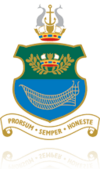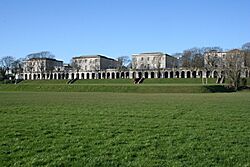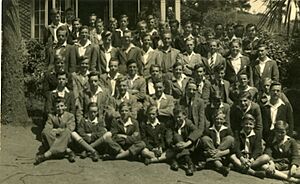Devonport High School for Boys facts for kids
Quick facts for kids Devonport High School for Boys |
|
|---|---|
 School badge  Devonport High School for Boys from Stonehouse Creek |
|
| Address | |
|
Paradise Road
Devonport, Plymouth
,
,
PL1 5QP
England
|
|
| Coordinates | 50°22′27″N 4°09′44″W / 50.374071°N 4.162273°W |
| Information | |
| Type | 11–18 boys Grammar school Academy |
| Motto | Latin: Prorsum Semper Honeste (Forward always honest/proud) |
| Established | 1896 |
| Founder | Alonzo Rider |
| Department for Education URN | 136496 Tables |
| Ofsted | Reports |
| Head teacher | Dan Roberts |
| Staff | Over 100 |
| Gender | Boys (Mixed sixth form) |
| Age | 11 to 18 |
| Enrolment | 1,150 (2011) |
| Houses | Turing Leslie Windsor Scott Attenborough Fleming Johnson |
| Colour(s) | |
| Former pupils | DHSB Old Boys |
| Website | Devonport High School for Boys |
Devonport High School for Boys is a school for boys aged 11 to 18 in Plymouth, Devon, England. It is a Grammar school, which means students are accepted based on their academic skills. The school is also an academy.
About 1,150 boys attend the school. Students come from Plymouth, southwest Devon, and southeast Cornwall.
Contents
School History
How the School Started
The school was started by Alonzo Rider on January 16, 1896. It was located in Stoke, Devonport. The school aimed to help boys who wanted to work in the Royal Navy or for the government.
In 1906, the Devonport Borough Council took over the school. For the next 30 years, it taught boys from the city and nearby areas. Many former students went on to work for the Ministry of Defence (MoD).
World War II and New Location
During World War II, in 1941, the school had to move to Penzance for safety. In 1945, it returned to its current location on Paradise Road. This building used to be the Stoke Military Hospital, built in 1797.
A book called A Torch in Flame tells the school's history. It was written by Henry Whitfeld, a former student and teacher. The school has also published an annual magazine since 1904. This magazine shares news with students, parents, and former students.
Specialist Status
Since 2002, the school has been known for its strong Engineering programs. In 2007, it also gained a special status for languages. Later, in 2009, it added "Applied Learning" as another special area. This encouraged teachers to connect subjects to real-world jobs.
School Life
Academic Achievements
In 2002, the school became one of the first four specialist engineering colleges in England. This means it was recognized for its excellent engineering teaching.
In 2007, the school also became a specialist in languages. By 2009, it added "Applied Learning" as a third special area. This helped students see how their lessons connect to future careers.
An inspection in 2011 called the school "Outstanding." This led to it becoming a "Type Two" Academy in March 2011. The inspection report said that students' achievements were "consistently high." It also noted that all students, including those with special needs, enjoyed learning. Teaching was described as "at least good and often outstanding."
School Houses
The school has different "houses" that students belong to. These houses compete in sports and other activities. Before 2009, there were four houses: Drake, Raleigh, Gilbert, and Grenville.
From 2009 to 2024, there were six houses: Campbell, Edison, Newton, Priestley, Smeaton, and Winstanley. Since 2024, there have been seven houses: Turing, Leslie, Windsor, Scott, Attenborough, Fleming, and Johnson.
The houses compete each year for the St Levan's Shield.
School Buildings
The school buildings are named after important people connected to Plymouth. Each building has a short name, usually its first letter, used for classroom numbers. Many blocks are connected by arches and balconies.
Here are some of the main buildings and who they are named after:
- Astor (A Block): Used for Biology, Engineering, Media Studies, and ICT. Named after Nancy Astor, Viscountess Astor, the first woman to be a Member of Parliament (MP) in the UK.
- Brunel (B Block): Used for Mathematics, Modern Foreign Languages, and English. Named after Isambard Kingdom Brunel, a famous engineer who designed railways and bridges.
- Burrows' Art Studio: An art room. Named after Clive Burrows, a former English and Drama teacher.
- Cookworthy (C Block): Used for Classics, History, and Geography. Named after William Cookworthy, who discovered china-clay in Cornwall.
- Drake (D Block): Used for Biology, Chemistry, Physics, and Astronomy. Named after Sir Francis Drake, a famous naval officer and former Mayor of Plymouth.
- Edgcumbe (E Block): The main office block, also has the library and gym. Named after the Earls of Mount Edgcumbe, whose family home is nearby.
- Edgcumbe Theatre: A large hall for performances.
- Foulston (F Block): The Sixth Form Centre and computer rooms. Named after John Foulston, an architect who designed many buildings in Plymouth.
- Gibbons (G Block): The dining hall and Food Technology rooms. Named after Edward Stanley Gibbons, a famous stamp collector from Plymouth.
- Hansom Sports Hall: A large hall for sports, assemblies, and exams. Named after Joseph and Charles Hansom, architects of Plymouth Cathedral.
- Jervis (J Block): The Music Suite. Named after John Jervis, 1st Earl of St Vincent, an admiral who helped build the Plymouth Breakwater.
- Kingsley Cottages: The Student Support Centre. Named after Charles Kingsley, a novelist who wrote The Water Babies.
Uzel House
The school used to have a special house in Uzel, France. It was bought for a very small amount of money in 1991. From 1992 to 2009, over 250 boys visited the house each year. They could gain work experience, practice French, and enjoy activities like horse riding. The house was closed in 2009.
Head Teachers
Here are the head teachers of Devonport High School for Boys:
- 1896–1906: AJ Rider
- 1906–1932: AF Treseder
- 1933–1941: HAT Simmonds
- 1942–1948: WH Buckley
- 1949–1953: SB Barker
- 1953–1974: JL Cresswell
- 1975–1993: JGW Peck
- 1993–2008: NM Pettit (Nic Pettit)
- 2008–2015: KJ Earley
- 2015–present: DJJ Roberts
Notable Former Pupils
Many successful people have attended Devonport High School for Boys. Here are a few:
- Ben Cross: An actor, known for the movie Chariots of Fire.
- John Dyson: A diplomat who was Ambassador to Montenegro.
- David Felwick: Former Deputy Chairman of John Lewis Partnership.
- Richard Foster: Former Chief Executive of the Crown Prosecution Service.
- Sir Martin Harris: A university leader, former Vice-Chancellor of the University of Manchester.
- Rear-Adm Terence Loughran: A naval officer who commanded HMS Ark Royal.
- Christopher Murphy: A former Member of Parliament (MP).
- Sir Austin Pearce: Former chairman of British Aerospace. He also captained the school's athletics and rugby teams.
- Tony Soper: A naturalist, author, and TV presenter.
- Tim Thornton: A Church of England bishop.
- Ian Trigger: A film and stage actor.



